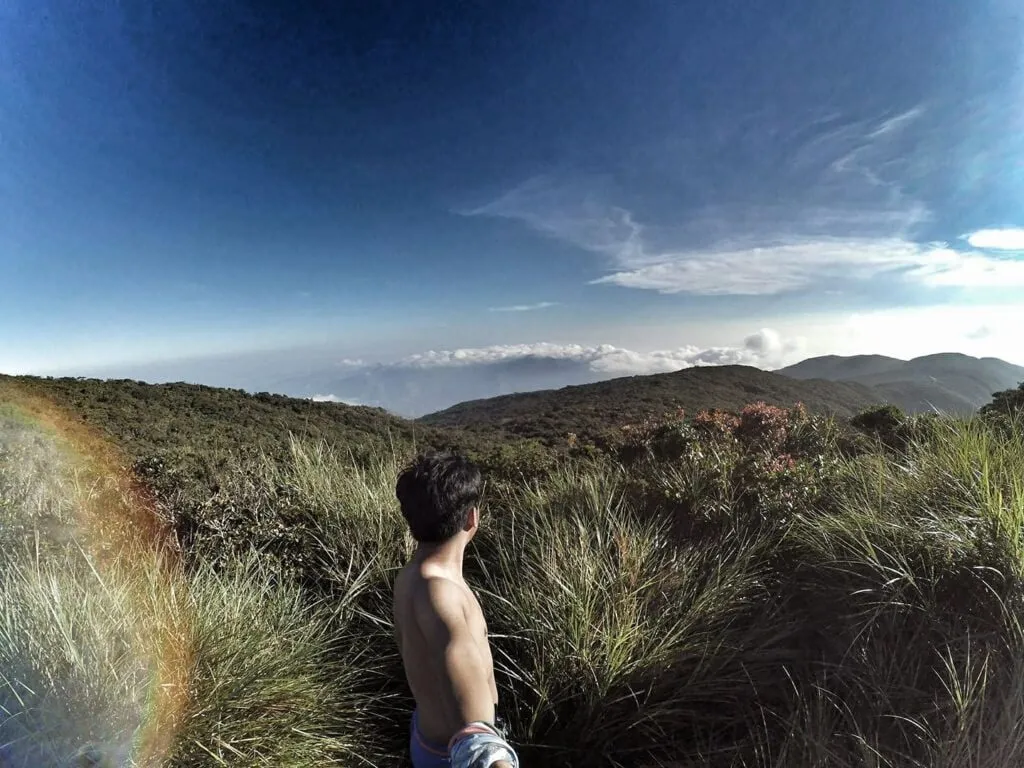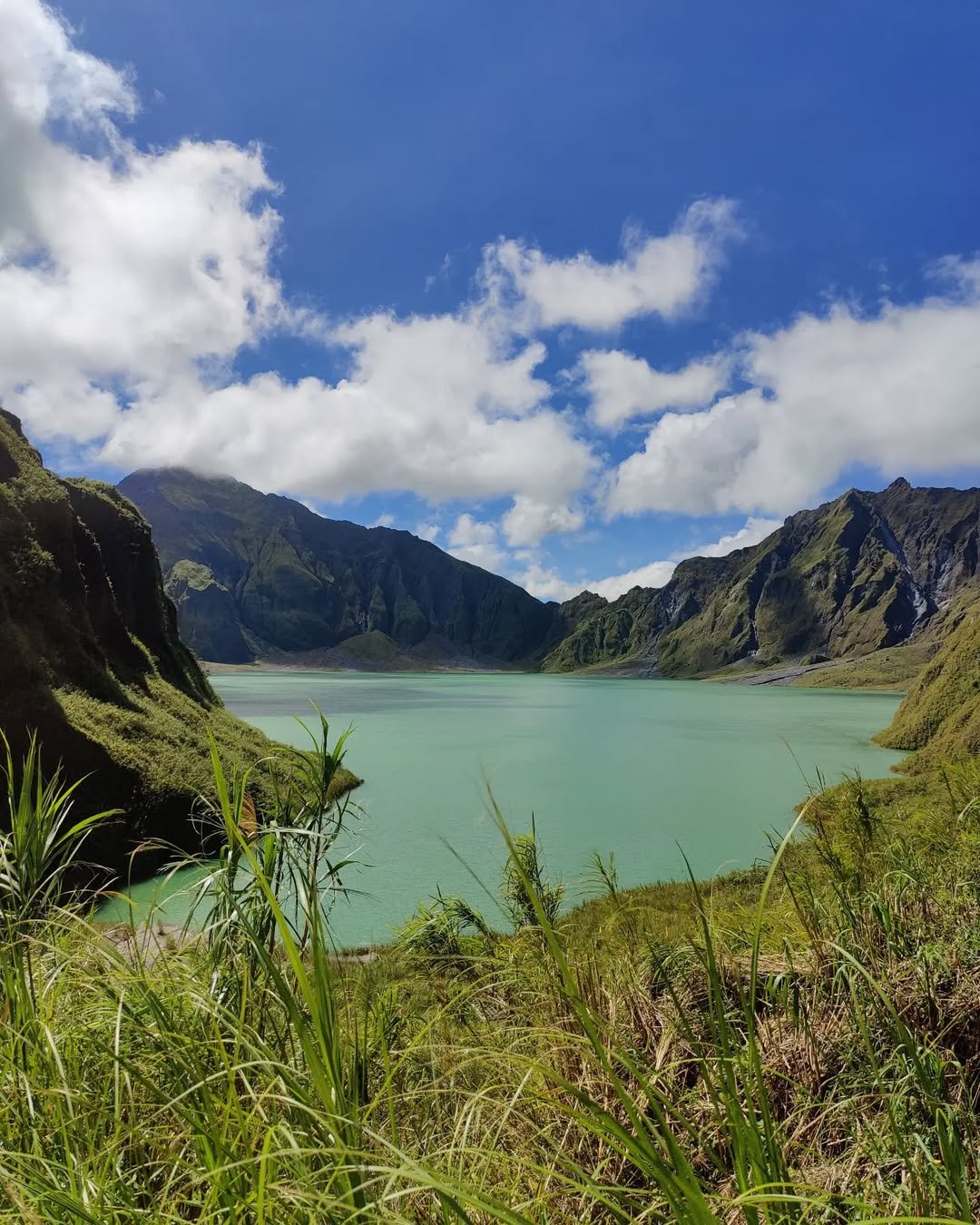
Introduction to Mount Pinatubo (Mt Pinatubo)
Tucked away in the heart of Central Luzon lies one of the Philippines’ most astonishing natural wonders — Mount Pinatubo. Once infamous for its catastrophic eruption in 1991, Mt. Pinatubo has since transformed into a breathtaking travel destination that blends raw geological power with serene, otherworldly beauty. Today, this volcano is no longer a symbol of devastation, but a testament to nature’s incredible ability to heal and amaze.
Mt Pinatubo is located at the tripoint of Zambales, Tarlac, and Pampanga provinces. Though its 1991 eruption was one of the most violent in recorded history — spewing ash across Southeast Asia and lowering global temperatures — it carved out a stunning crater now filled with a turquoise lake that draws thousands of adventurers and nature lovers each year. This remarkable transformation makes Mt. Pinatubo one of the most unique hiking destinations in the Philippines.
Visiting Mount Pinatubo isn’t just about the destination — it’s about the journey. From a bumpy 4×4 off-road ride across ash-laden valleys to an accessible trek through rugged canyons, the experience delivers both excitement and reflection. Whether you’re a seasoned hiker or a first-time explorer, the trail to the crater rewards you with unforgettable views and the quiet majesty of a landscape shaped by fire and water.
In a country full of islands and beaches, Mt. pinatubo offers something refreshingly different — a raw, scenic, and humbling encounter with the power of nature.
Table of Contents
Where Is Mount Pinatubo Located?
If you’re wondering where Mount Pinatubo is located, the answer may surprise you—it’s closer than you think. Nestled in the heart of Central Luzon, the volcano sits quietly at the convergence of three provinces: Pampanga, Tarlac, and Zambales. This tri-provincial boundary places Mt Pinatubo right within reach of some of the Philippines’ busiest travel hubs, making it an accessible adventure for weekend warriors and international tourists alike.
Mt Pinatubo Location and Regional Access
The most commonly used access point to Mt. Pinatubo is Barangay Sta. Juliana in Capas, Tarlac. From here, all official 4×4 tours and hikes are launched. This jump-off is strategically located, offering travelers a smooth transition from urban to rugged terrain in just a few hours.
For context, here’s how close Mt. Pinatubo is to key cities:
From Manila: Roughly 2.5 to 3 hours by private car via NLEX and SCTEX. Public buses headed to northern Luzon can drop you at Capas Junction, where tricycles are available to Sta. Juliana.
From Clark (Angeles City): Only about 1.5 hours away. Clark International Airport is the closest major airport, ideal for domestic and international travelers seeking a fast track to the trailhead.
From Baguio: Around 3.5 to 4 hours by bus or van. North Luzon travelers can easily reach Capas via southbound buses.
So, if you’re plotting an escape from the city or building a Luzon itinerary, Mt Pinatubo’s location is ideal. It’s remote enough to feel wild, yet connected enough to be conveniently reached from Manila, Clark, or Baguio. Whether you’re coming from Manila, from Clark, or from Baguio, the road to mt pinatubo promises an unforgettable transition from concrete to crater.
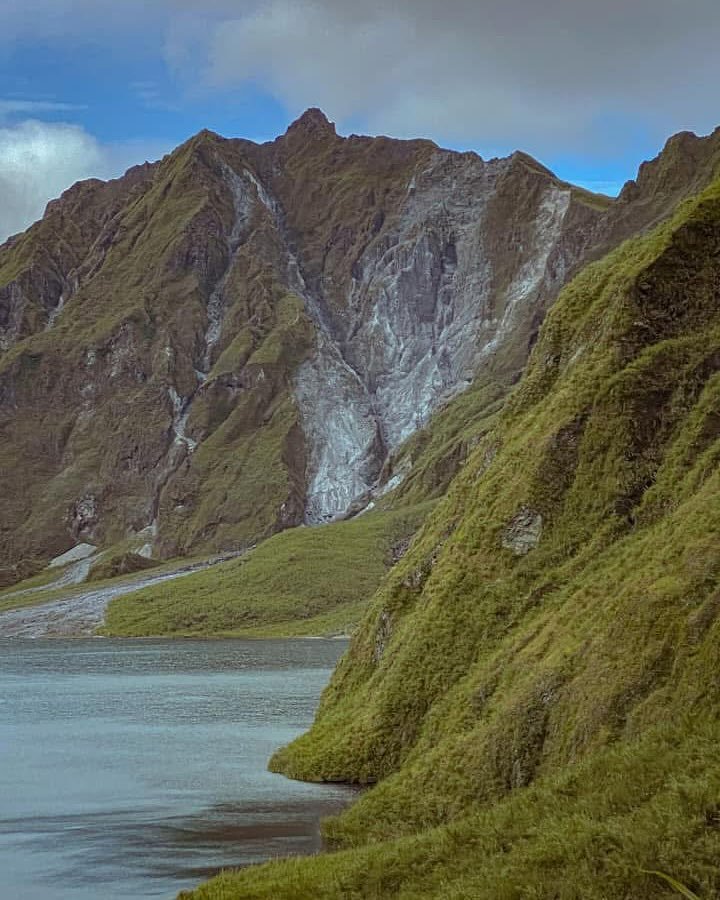
Mt Pinatubo History & Eruption Background
A Sleeping Giant Awakened: Mt Pinatubo Eruption History
Long before it became a hiking haven, Mt Pinatubo was an unassuming peak cloaked in dense forest, largely unnoticed by locals and geologists alike. That all changed in 1991, when the mountain unleashed one of the most powerful volcanic eruptions of the 20th century. For centuries, Mt. Pinatubo had shown little sign of activity. In fact, it hadn’t erupted for over 600 years — which is why so many were caught off guard.
So, when did Mount Pinatubo erupt? The answer: June 15, 1991. That day, the volcano erupted with such force that it ejected over five cubic kilometers of ash and volcanic debris into the atmosphere. The plume soared over 30 kilometers high, blanketing parts of Luzon in darkness. The eruption coincided with Typhoon Yunya, intensifying the disaster as heavy rains turned volcanic ash into destructive lahars that buried towns and farmlands.
The global effects were just as staggering. The eruption caused a 0.5°C drop in global temperature for over a year due to the vast amount of sulfur dioxide released into the stratosphere. The mt pinatubo eruption history serves as a stark reminder of nature’s raw power.
Is Mount Pinatubo Active or Inactive Today?
Today, travelers often ask: is Mount Pinatubo active? or is Mt Pinatubo active or inactive? The official answer is: Mt. Pinatubo is classified as an active volcano, though currently dormant. It had minor steam-driven activity in 2021, but no lava flow or major threat was recorded. The Philippine Institute of Volcanology and Seismology (PHIVOLCS) monitors it closely and considers it safe for tourism under normal conditions.
In short, mt pinatubo history is both terrifying and awe-inspiring — a tale of destruction turned into discovery, and a living classroom for volcano watchers and adventurers alike.
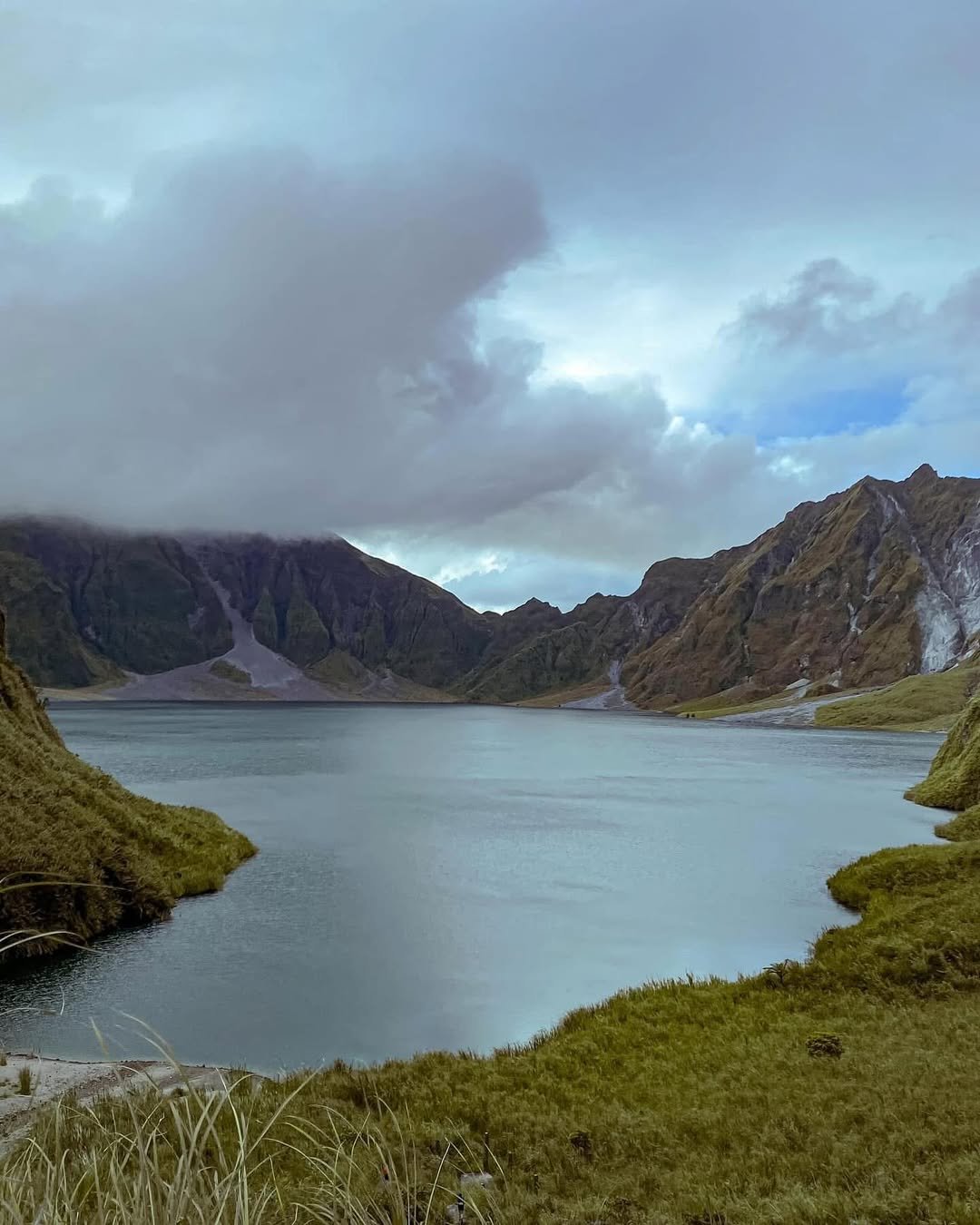
What Type of Volcano is Mt Pinatubo? – Geological Facts
Understanding the Nature of Mount Pinatubo
So, what type of volcano is Mt Pinatubo? Mount Pinatubo is classified as a stratovolcano — also known as a composite volcano — which is among the most explosive and potentially dangerous volcano types on Earth. Stratovolcanoes are built up by layers of hardened lava, tephra, and volcanic ash, forming steep, conical mountains that can remain dormant for centuries before erupting violently.
Unlike shield volcanoes with gentle lava flows, stratovolcanoes such as Mount Pinatubo are characterized by high-viscosity magma, which traps gases and builds immense pressure. When this pressure is released, the eruption is typically sudden and cataclysmic — just like Pinatubo’s historic 1991 eruption.
Mt Pinatubo’s Structure and Altitude Shift
Before the 1991 eruption, Mt Pinatubo MASL (meters above sea level) was estimated at around 1,745 meters. But when the volcano blew its top, the summit collapsed inward, forming a massive caldera — now home to its famed crater lake. The result? A dramatic reduction in elevation. Today, Mount Pinatubo stands at approximately 1,486 meters MASL — nearly 260 meters shorter than its original height.
This reshaping of the mountain is a defining characteristic of stratovolcanoes. Eruptions can literally transform the landscape, carving new features while erasing old ones. In the case of Mt Pinatubo, what was once a forested peak became a wide crater rimmed with jagged cliffs and filled with turquoise water.
Understanding the geological identity of Mt Pinatubo isn’t just scientific trivia — it’s a key to appreciating how this mountain continues to evolve, fascinate, and challenge those who visit it.
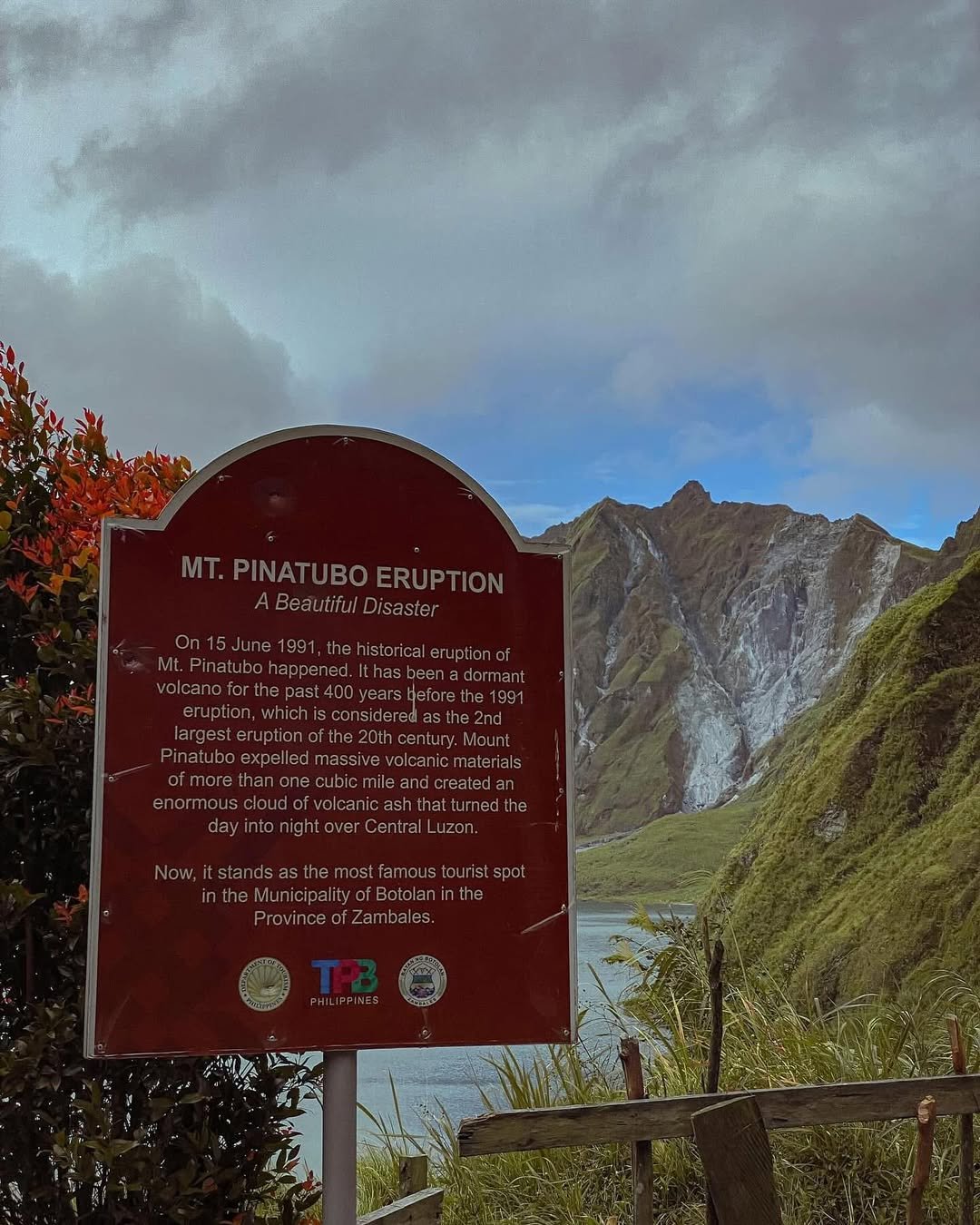
Mt Pinatubo Crater Lake – A Stunning Reward
The Jewel in the Heart of a Volcano
At the end of your trek through lahar canyons and sun-scorched valleys lies one of the most breathtaking sights in the Philippines — the Mt Pinatubo crater lake. Nestled inside the massive caldera formed by the 1991 eruption, this natural wonder surprises many with its surreal beauty. Calm, turquoise waters fill the once-fiery core, surrounded by towering cliffs that seem to guard it like a hidden treasure.
What makes the Mt Pinatubo crater lake truly remarkable is how it came to be. After the volcano’s summit collapsed during the eruption, the resulting crater slowly filled with rainwater over the next decade. By the early 2000s, the lake had become a deep, vibrant body of water — first acidic, but gradually diluted over time. Today, its still surface reflects the clouds and cliffs above, offering a stark contrast to the rugged terrain that surrounds it.
Reaching the Viewpoint
To get to the crater, visitors complete a scenic hike after an exciting 4×4 ride. The final stretch includes a short uphill path with stone steps leading to the main view deck — your first panoramic look at the lake. It’s a moment most hikers never forget.
The site is well-maintained with designated paths and picnic spots. While swimming is strictly prohibited for safety and environmental reasons, the area is perfect for taking photos, relaxing, and soaking in the cool breeze that rolls over the crater rim.
Things to Do at the Crater
Photography – Capture stunning views of the lake and caldera from different angles.
Picnicking – Many hikers bring lunch to enjoy with a view.
Sightseeing – Explore the surrounding cliff edges and appreciate the contrast of destruction and beauty.
Reflection – It’s hard not to feel humbled in a place where nature reclaimed its fury with silence and stillness.
When listing things to do in Mt Pinatubo, standing at the edge of its crater lake easily tops the list. It’s the reward at the end of a dusty, thrilling journey — a visual and emotional payoff that lingers long after you’ve left the mountain.
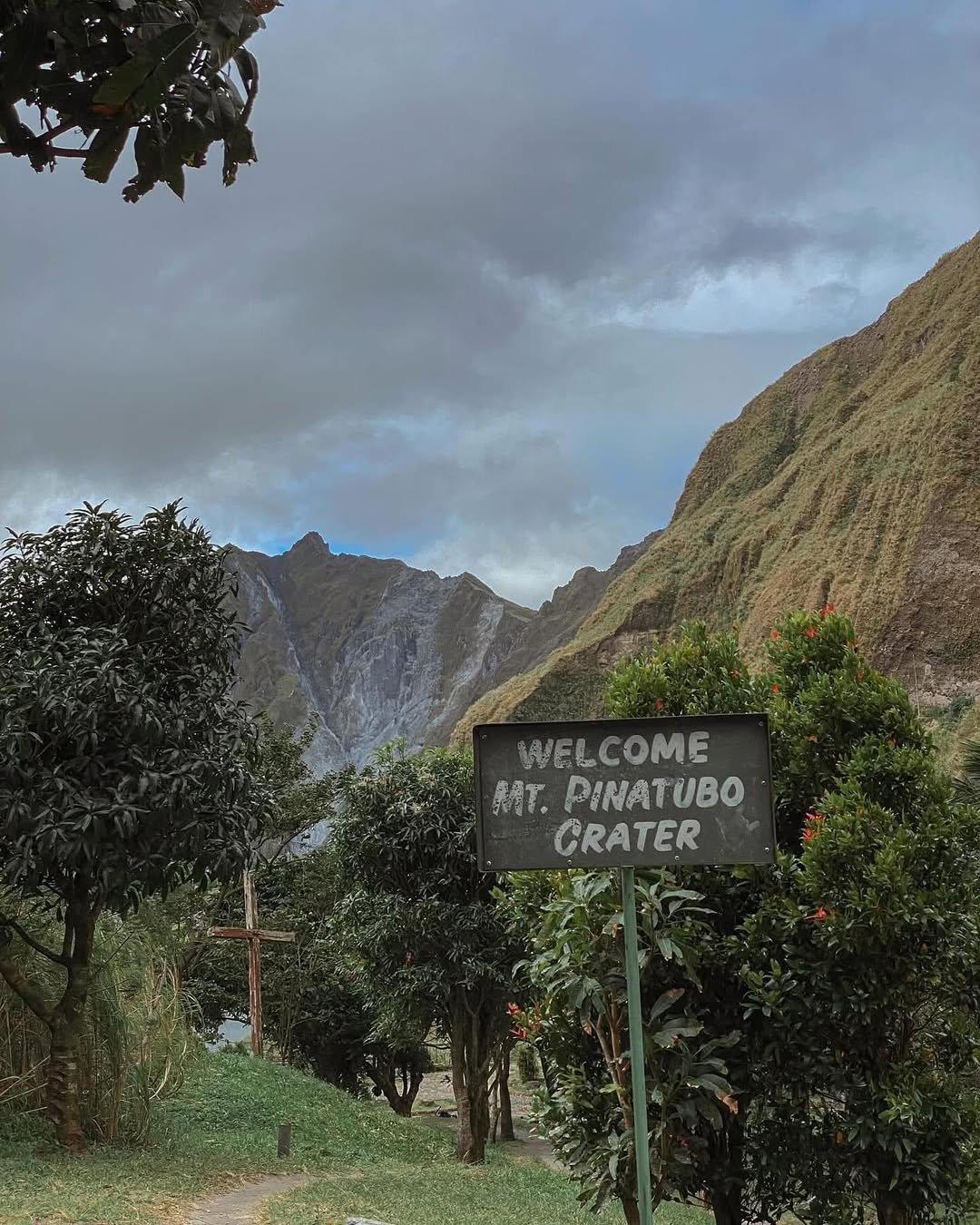
Mt Pinatubo Hiking Experience – Everything You Need to Know
The Trail to a Crater Like No Other
The Mt Pinatubo hike is more than just a trail — it’s a journey across a landscape carved by one of the most powerful volcanic eruptions in modern history. Despite its dramatic past, the route is surprisingly beginner-friendly, offering a unique adventure that’s accessible even for first-time hikers.
Trail Overview and Terrain
Your hiking experience begins after a thrilling 4×4 off-road ride across ash-gray valleys and shallow streams. Once the jeep drops you off at the final trailhead, the actual Mt Pinatubo hike spans approximately 5.5 kilometers one way, making it an 11-kilometer round-trip. The average hike takes 1.5 to 2 hours each way, depending on your pace and weather conditions.
The path cuts through wide, dry riverbeds and canyon-like lahar formations, remnants of the 1991 eruption. As you walk, you’ll pass surreal rockscapes, trickling streams, and the famous “Toblerone Hills” — sharply shaped, triangular lahar mounds that look like a giant’s candy stash. There are no steep ascents or technical climbs, which makes the hike more enjoyable than exhausting.
Mt Pinatubo Hike Difficulty
So, how hard is it really? On the local mountaineering scale, Mt pinatubo hike difficulty is rated at 2/9 — low to moderate. The trail is mostly flat with a few gradual inclines and uneven surfaces. It’s suitable for families, beginners, and even seniors, provided they’re in good health. The real challenge lies in the sun exposure, river crossings, and occasional muddy paths after rainfall.
You don’t need any technical skills, but you do need:
Comfortable hiking shoes or sandals with grip
Sun protection (hat, sunscreen, sunglasses)
A good water supply (at least 2 liters per person)
Scenery and Experience
What makes Mt pinatubo hiking unforgettable is the landscape. The terrain looks almost otherworldly — ash-colored plains, cliffs eroded into strange shapes, and valleys that echo when you speak. Every turn of the trail reveals something new. You won’t just be walking; you’ll be immersed in a place where time and lava have redrawn the Earth.
If you’re seeking a hike that’s rewarding but not punishing, Mt Pinatubo is a top pick. The trail isn’t just a route to a crater — it’s a moving story of destruction and renewal, one that unfolds with every step you take.

How to Go to Mt Pinatubo – Complete Transportation Guide
Getting to Mt Pinatubo is part of the adventure. Whether you’re traveling from Manila, from Clark, or from Baguio, reaching the jump-off point in Sta. Juliana, Capas, Tarlac is surprisingly straightforward — and scenic. Here’s everything you need to know to plan your trip.
From Manila to Mt Pinatubo
If you’re wondering how to go to Mt Pinatubo from Manila, you have two main options:
By private car:
Travel time: 2.5 to 3 hours
Route: Take NLEX, exit at SCTEX, then head toward Capas, Tarlac. Follow the signs to Sta. Juliana.
Ideal for early departures (leave by 3:00 AM to catch the hike window).
By bus + tricycle:
Ride a bus bound for Baguio or Pangasinan and ask to be dropped off at Capas Junction (₱200–₱250, 2.5–3 hours).
From Capas, hire a tricycle to Sta. Juliana Tourism Center (~₱300 per ride, 30–45 minutes).
Be at the tourism office by 6:00 AM.
From Clark (Angeles City or Clark Airport)
Clark is the closest urban hub to Mt Pinatubo, making it perfect for travelers flying in domestically or internationally.
By car or van:
Travel time: ~1.5 hours
Drive through SCTEX to Capas, then onward to Sta. Juliana.
By public transit:
Take a jeep or taxi to Dau Terminal.
Ride a northbound bus to Capas (₱100–₱150), then tricycle to the jump-off point.
Quick and budget-friendly.
From Baguio to Mt Pinatubo
Those coming from Baguio can head south via:
By bus:
Ride a bus bound for Manila (Victory Liner or Genesis), ask to get off at Capas Junction (~₱250–₱300, 3.5–4 hours).
From Capas, take a tricycle to Sta. Juliana.
Travel Tip: Regardless of your starting point, plan to arrive at Sta. Juliana between 5:30 AM and 6:00 AM. Tours depart early, and late arrivals may not be accommodated.
So whether you’re coming from Manila, from Clark, or from Baguio, getting to Mt Pinatubo is half the fun — and fully worth the effort.
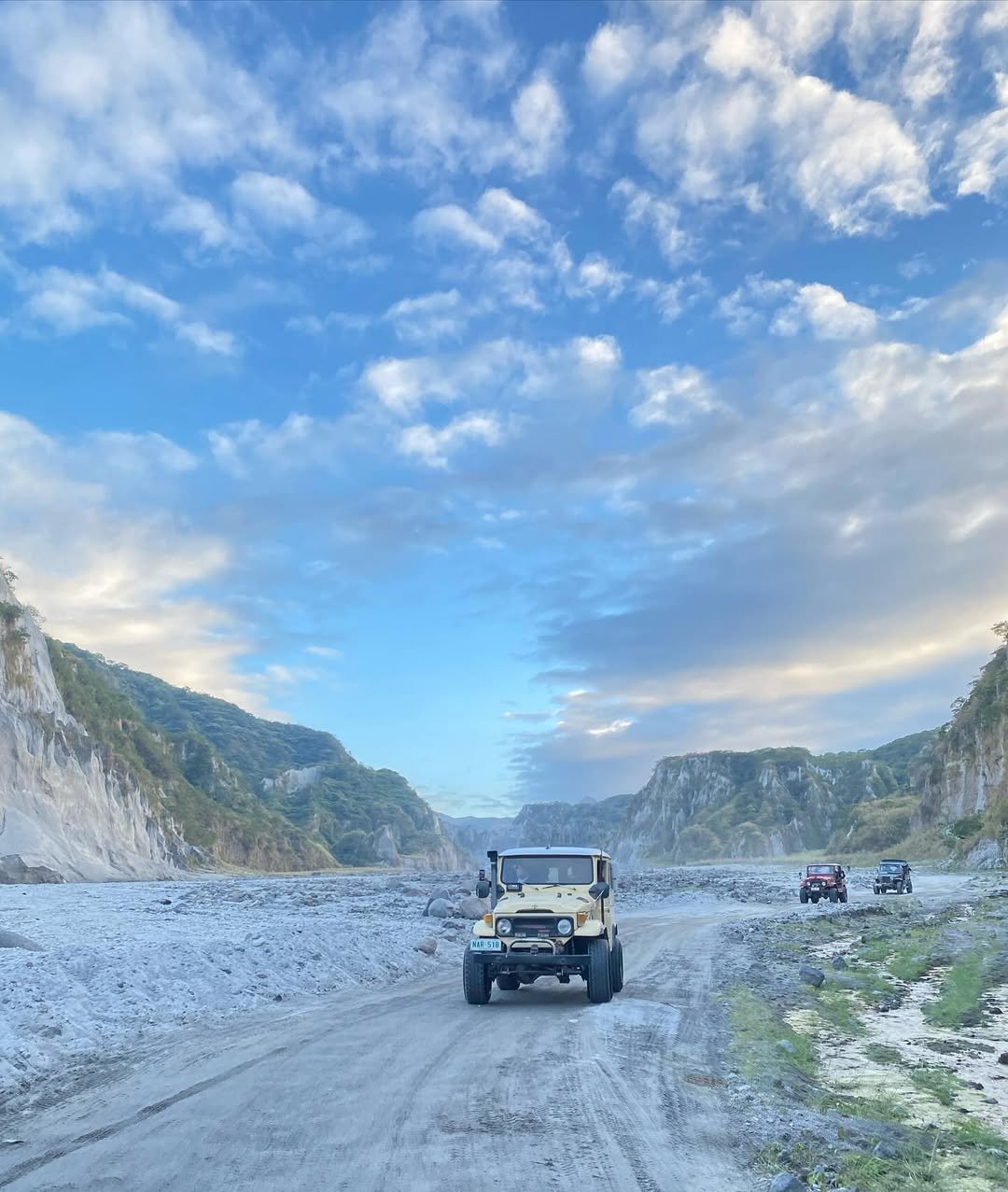
Mt Pinatubo 4×4 Adventure – Essential Guide & Rentals
Why You Need a 4×4 for Mount Pinatubo
A hike to Mt Pinatubo doesn’t begin with your feet — it starts with four wheels. A 4×4 vehicle is absolutely necessary to access the trailhead, as the route from the Sta. Juliana jump-off to the base of the hike cuts across a vast lahar desert, shallow rivers, and ash-covered valleys. This isn’t a job for ordinary cars. The terrain is rugged, dusty, and constantly shifting — the kind of environment only a heavy-duty off-road vehicle can handle.
Mt Pinatubo 4×4 Rental Details
The standard mt pinatubo 4×4 rental includes a driver and space for up to five passengers. Most rentals are arranged at the Sta. Juliana Tourism Center in Capas, Tarlac. Here’s what you need to know:
Rental fee: ₱3,000 to ₱3,500 per 4×4 (round trip)
Passenger capacity: Maximum of 5 people per jeep
Inclusions: Driver, fuel, and drop-off at the trailhead
Booking: Can be arranged on-site or included in tour packages
What to Expect on the Ride
Expect a bumpy, exhilarating 45–60-minute ride through one of the most surreal landscapes in the country. You’ll splash through shallow streams, bounce over volcanic debris, and cruise across endless gray plains framed by jagged canyons. The open-air ride is dusty but thrilling — don’t forget a scarf or mask to cover your nose and mouth.
The Mt pinatubo 4×4 ride isn’t just transportation; it’s an adventure in itself. For many, it’s a highlight of the trip — the wild, windswept prelude to the calm beauty of the crater lake. If you’re heading to Mount Pinatubo, buckle up — the real journey begins before the hike even starts.
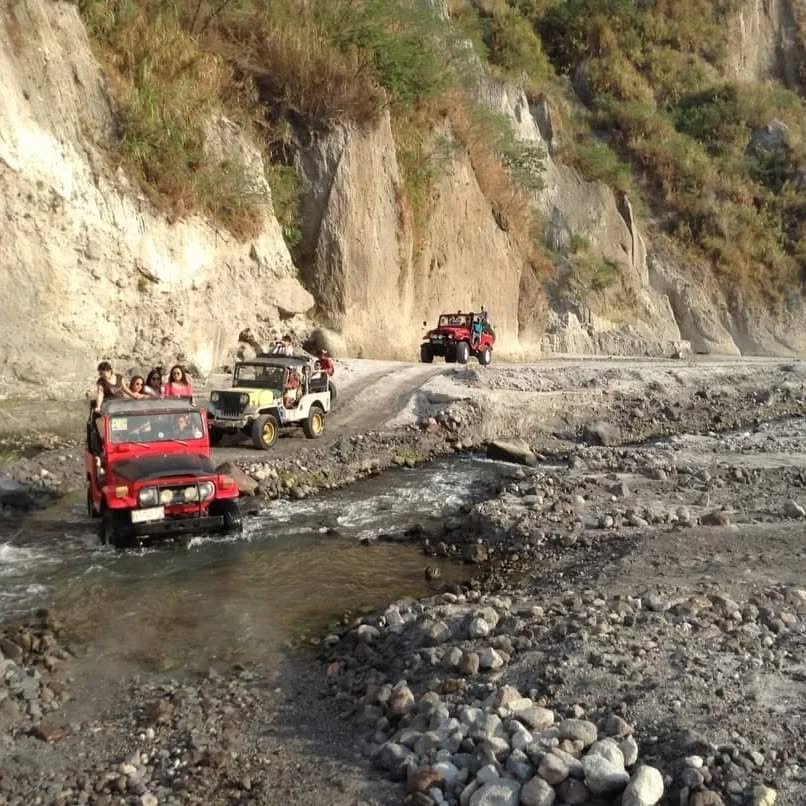
Best Time to Hike Mt Pinatubo – Seasonal Guide
When to Go: Timing Your Hike Right
The best time to hike Mt Pinatubo is during the dry season, which runs from December to May. These months offer the most stable weather conditions, with clear skies, cooler mornings, and dry trails — perfect for enjoying both the hike and the stunning views of the crater lake.
January to March is especially ideal, thanks to the pleasant temperature and lower chances of rain. During these months, you can expect crisp morning air, minimal humidity, and vibrant scenery, making the experience even more rewarding.
Why You Should Avoid the Rainy Season
Hiking during the rainy season (June to September) is strongly discouraged. The region is prone to flash floods, slippery trails, and lahar flows, all of which pose serious risks. Even a light rain can quickly turn the lahar valleys into dangerous mud pits. Most tour operators suspend trips during bad weather for safety reasons.
In addition to safety concerns, poor weather conditions during the wet season also mean cloudy or zero visibility at the crater — making the long journey far less fulfilling.
So, if you’re planning your trip to Mt Pinatubo, aim for dry months. Trust us — clear skies and a turquoise crater lake are absolutely worth the wait.
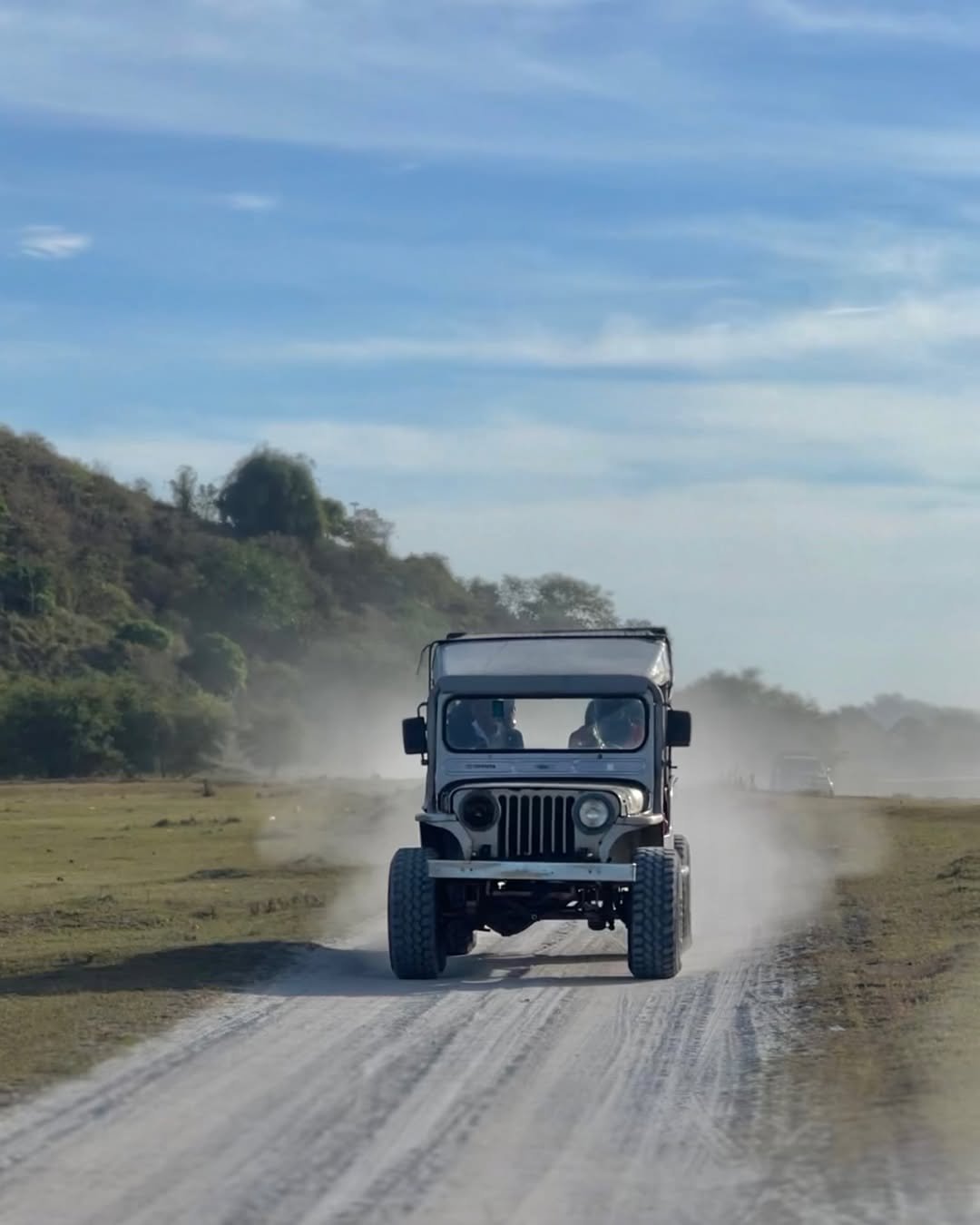
Mt Pinatubo Guide Fees & Permit Requirements
Do You Need a Guide to Hike Mt Pinatubo?
Yes — hiring a Mt pinatubo guide is mandatory for all visitors. This ensures safety, trail compliance, and local livelihood support. In addition, hikers must secure a permit and pay standard fees at the Sta. Juliana Tourism Center in Capas, Tarlac.
Fee Breakdown
Guide Fee: ₱500 per group (standard rate for a licensed local guide)
Environmental/Registration Fee: ₱300 per person
4×4 Jeep Rental: ₱3,000–₱3,500 (required to reach the trailhead; shared cost)
Your guide not only leads the trek but also shares safety tips and cultural insights — especially if they belong to the Aeta community, the area’s indigenous group.
Where to Get Permits
Permits are processed on-site at Sta. Juliana before your hike. For a smoother experience, some tour operators include permits, guide fee, and 4×4 rentals in their packages.
Securing a Mt Pinatubo guide is not just a rule — it’s part of what makes this trip organized, respectful, and truly memorable.
What to Pack for Your Mt Pinatubo Adventure – Essentials & Outfit
Mt Pinatubo Essentials: What You Need for a Smooth Hike
Packing smartly for your Mt Pinatubo trip makes all the difference between a fun trek and a miserable one. The terrain is dry and rugged, and weather conditions can shift quickly — so comfort, protection, and practicality should guide your gear choices.
Recommended Mt Pinatubo Outfit
Start with lightweight, moisture-wicking clothes — dri-fit shirts, leggings, or athletic shorts work well. The hike is exposed, so wear a hat or cap, sunglasses, and apply sunscreen generously. Bring a buff or face mask to protect against dust during the 4×4 ride and trail.
Footwear: Trail shoes or running shoes with good grip
Extra set of clothes: For changing after the hike (optional, but useful)
Light rain jacket or poncho (especially in shoulder months)
Mt Pinatubo Essentials for Your Backpack
You don’t need to overpack, but you shouldn’t go unprepared either. Here are key mt pinatubo essentials:
Water – Minimum 2 liters per person
Trail snacks or packed lunch
Sunscreen – SPF 30 or higher
Camera or smartphone – For those jaw-dropping crater shots
Small towel, alcohol/sanitizer, and tissues
First aid basics – Band-aids, antihistamine, or personal meds
Waterproof bag or dry pouch for electronics
Travel Tips for Comfort and Safety
One of the best Mt pinatubo travel tips is to start early to avoid the heat and reach the crater before the sun is at its peak. Keep your backpack light but complete. Dress for both heat and dust — and always wear something you don’t mind getting a little dirty.
In short, the right essentials and outfit will help you enjoy Mt Pinatubo safely, comfortably, and in style.
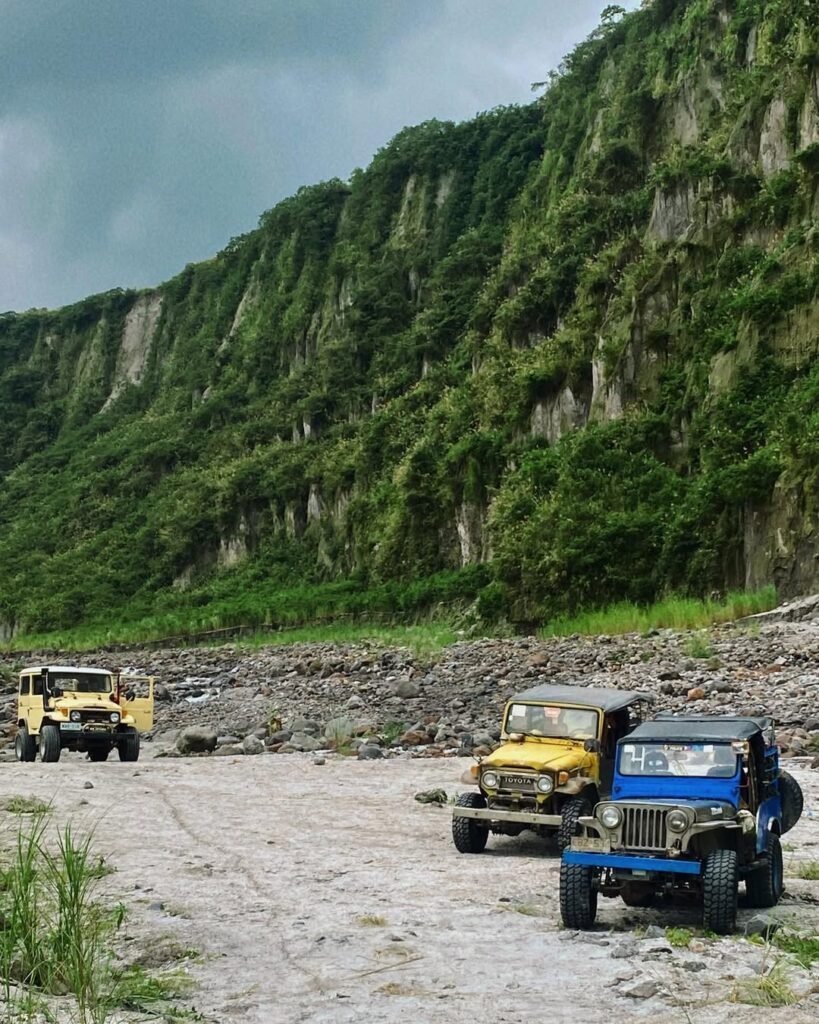
Important Travel Tips for Visiting Mount Pinatubo
Stay Safe and Prepared on the Trail
One of the most essential Mt Pinatubo travel tips is to be prepared for the terrain and climate. The hike is not steep, but it’s long, sun-exposed, and dusty. Wear proper footwear and bring a scarf or mask to protect against volcanic dust, especially during the 4×4 ride.
Always stay on the official trail and follow your guide’s instructions. Straying too close to lahar cliffs or stream beds can be dangerous, especially after rainfall. The area may look stable, but loose volcanic soil can collapse without warning.
Hydrate, Protect, and Pace Yourself
Bring at least 2 liters of water per person — dehydration is a common issue due to direct sunlight and the effort of hiking. Apply high-SPF sunscreen before and during the trek, and wear a wide-brimmed hat or cap. Avoid hiking if you have any serious health conditions unless cleared by a doctor.
Be a Responsible Visitor
Mount Pinatubo is not only a natural wonder — it’s sacred land for the indigenous Aeta people. Respect their culture and presence along the trail. Avoid loud behavior, don’t litter, and purchase local crafts when available to support the community.
In short, Mount Pinatubo offers an unforgettable experience — as long as you travel smart, stay respectful, and come prepared.
Things to Do Near Mt Pinatubo
While the crater lake is the star of the show, there are other things to do in Mt Pinatubo and its surrounding areas that can round out your trip with relaxation, culture, and adventure.
1. Puning Hot Springs
Located on the Pampanga side of Mt Pinatubo, Puning Hot Springs offers a post-hike spa experience like no other. Soak in natural hot spring pools, enjoy an ash mudpack treatment, or simply relax in nature with mountain views. This is perfect for tired muscles after the long hike.
2. Cultural Encounters with the Aeta Community
Many local guides belong to the indigenous Aeta people. Some tour packages include visits to nearby villages where you can learn about their culture, traditions, and resilience after the 1991 eruption.
3. Photography and Scenic Stops
The surreal landscape around Mount Pinatubo — from the Toblerone Hills to lahar canyons — offers endless opportunities for photos. For adventure travelers and content creators, it’s a visual goldmine.
Frequently Asked Questions About Mt Pinatubo
1. Where is Mount Pinatubo Located?
Mt Pinatubo is located in Central Luzon, at the border of Tarlac, Pampanga, and Zambales provinces. The main access point is through Sta. Juliana in Capas, Tarlac, around 2.5 to 3 hours from Manila.
2. Is Mount Pinatubo Active?
Yes, Mount Pinatubo is an active volcano, though it is currently dormant. The most recent activity was a minor phreatic (steam-driven) explosion in 2021. It is closely monitored and considered safe for tourism under Alert Level 0.
3. When Did Mount Pinatubo Erupt?
Mt Pinatubo erupted on June 15, 1991, in one of the largest volcanic events of the 20th century. It drastically reshaped the landscape and lowered global temperatures due to its massive ash plume.
4. What Is the Mt Pinatubo Difficulty Level?
The hike is rated 2/9 in difficulty, making it suitable for beginners. Expect a 5.5 km one-way trek (11 km round-trip) over flat, rocky lahar fields. Most hikers complete it in 1.5 to 2 hours each way.
5. Any Final Mt Pinatubo Tips?
Start early, wear sun protection, bring water and snacks, and always follow your guide. It’s a wild yet accessible adventure — just come prepared and respectful.
Conclusion – Why You Should Visit Mt Pinatubo
Mount Pinatubo is a rare destination that tells a powerful story — one of destruction, renewal, and raw natural beauty. From the thrilling 4×4 ride to the scenic crater lake framed by dramatic cliffs, every step toward the summit is unforgettable. Whether you’re drawn by adventure, geology, or photography, Mt Pinatubo offers an experience unlike any other in the Philippines.
It’s accessible, beginner-friendly, and deeply rewarding. So if you’re looking for a day trip that’s both thrilling and humbling, Mt. pinatubo should be at the top of your list. Go for the view, stay for the story.


